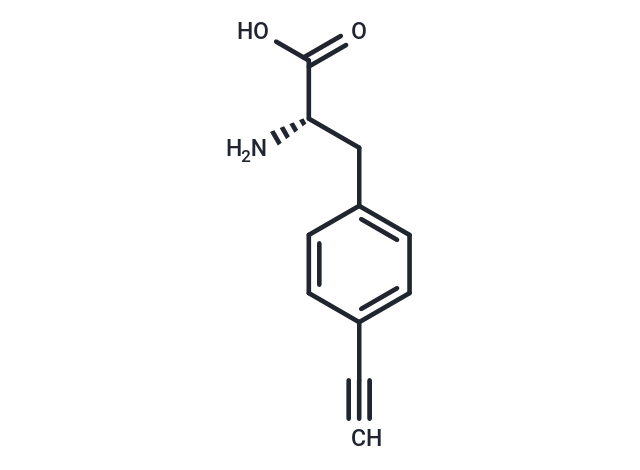Shopping Cart
- Remove All
 Your shopping cart is currently empty
Your shopping cart is currently empty

p-Ethynylphenylalanine (4-Ethynyl-L-phenylalanine), a selective, effective, and reversible tryptophan hydroxylase (TPH) inhibitor, exhibits competitive inhibition with a Ki of 32.6 μM.

| Pack Size | Price | Availability | Quantity |
|---|---|---|---|
| 10 mg | $34 | In Stock | |
| 25 mg | $55 | In Stock | |
| 50 mg | $80 | In Stock | |
| 1 mL x 10 mM (in DMSO) | $89 | In Stock |
| Description | p-Ethynylphenylalanine (4-Ethynyl-L-phenylalanine), a selective, effective, and reversible tryptophan hydroxylase (TPH) inhibitor, exhibits competitive inhibition with a Ki of 32.6 μM. |
| Targets&IC50 | TPH:32.6 μM (Ki), TPH:ki:32.6 μM |
| In vivo | 4-Ethynyl-L-phenylalanine (30 mg/kg; i.p.) decreases in 5-HT and 5-HIAA levels in the rat midbrain but not in tissue. It is not inhibiting the aromatic amino acid decarboxylase. It has a low affinity for various recombinant 5-HT receptors. |
| Alias | 4-Ethynyl-L-phenylalanine |
| Molecular Weight | 189.21 |
| Formula | C11H11NO2 |
| Cas No. | 278605-15-5 |
| Smiles | N[C@@H](Cc1ccc(cc1)C#C)C(O)=O |
| Relative Density. | 1.21 g/cm3 (Predicted) |
| Storage | Powder: -20°C for 3 years | In solvent: -80°C for 1 year | Shipping with blue ice. | ||||||||||||||||||||||||||||||||||||||||
| Solubility Information | 1M HCl: 216.0 mg/mL (1141.6 mM), when pH is adjusted to 1 with HCl. Sonication is recommended. DMSO: 2.0 mg/mL (10.6 mM), Sonication is recommended. 1M NaOH: 216.0 mg/mL (1141.6 mM), when pH is adjusted to 11 with NaOH. Sonication is recommended. | ||||||||||||||||||||||||||||||||||||||||
Solution Preparation Table | |||||||||||||||||||||||||||||||||||||||||
DMSO/1M HCl/1M NaOH
1M HCl/1M NaOH
| |||||||||||||||||||||||||||||||||||||||||

Copyright © 2015-2025 TargetMol Chemicals Inc. All Rights Reserved.